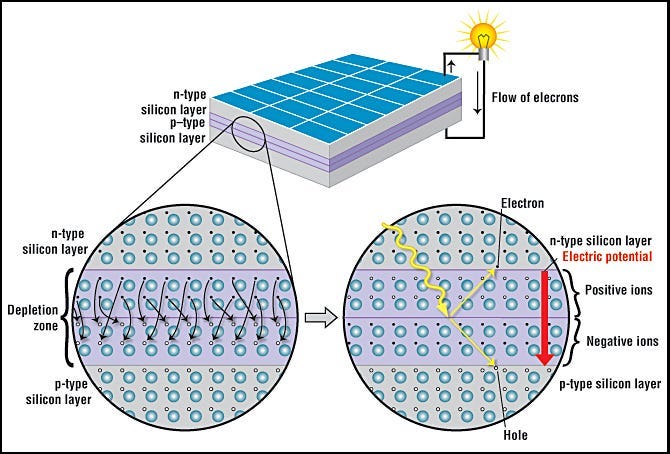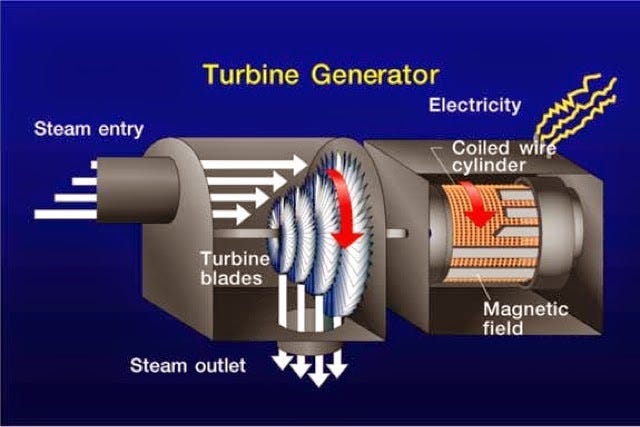Making Green Energy
Or Creative Ways to Spin a Magnet
One of my New Year’s resolutions for Current History is to use my engineering background to write more pieces on how technologies important to global policy actually work.
An easy place to start is green energy generation. Generating electricity is fundamentally a process of energy conversion. In the case of solar panels, it’s using chemistry to transform solar energy into electricity. In all other cases, it involves converting mechanical power into electricity using the principles of electromagnetism.
Spinning Magnets
When a magnet is spun inside a wire coil, the magnetic field induces an electrical current in the direction of the rotation. This current runs through the coil, through a connected wire, and to wherever it’s needed. Power generation, with the exception of solar panels, is largely a question of getting the magnet to spin.
In the case of fossil fuels, combustion is used to boil water, and the steam spins a turbine connected to a magnet. With nuclear power, the heat generated from the splitting of uranium atoms creates the steam. These are both cases of turning chemical energy into mechanical energy, and finally into electrical energy.
Wind and hydroelectric sources use the same principle to generate electricity but by different means. In these cases, a flowing fluid (air or water) spins a turbine connected to a magnet. Inside a hydroelectric dam are massive turbines, and the continuous flow of water spins these turbines and generates continuous power. Wind is less consistent, and a series of transformers and batteries are required to produce a regular power supply.
Harnessing the Sun
Solar energy generation works a bit differently. It uses the energy of the sun to induce a chemical reaction that creates an electrical current. Specifically, it uses the photovoltaic effect produced when sunlight strikes a solar cell, the main component of a solar panel.
A solar cell is made of two types of semiconductors, called p-type and n-type silicon. The p-type silicon is produced by adding atoms, such as boron or gallium, that have one less electron in their outer energy level than silicon. Because these elements have one less electron than is required to form the bonds with the surrounding silicon atoms, an electron vacancy or “hole” is created with a net positive charge.
Incidentally, gallium is one of the rare critical minerals that has featured more heavily in recent policy discussions. Silicon, as the main base material of these semiconductors, is even more vital.

The n-type silicon is made by including elements whose atoms that have one more electron in their outer level than silicon does, such as phosphorus or aluminum. Phosphorus has five electrons in its outer energy level, not four. It bonds with its silicon neighbor atoms, but one electron is not involved in bonding. Instead, it is free to move inside the silicon structure, creating a net negative charge.
When sunlight strikes a semiconductor, the extra energy allows electrons to essentially detach from their atoms and flow freely in the material, like in a conductive metal. The negatively charged electrons flow in the direction of positive charge, or from the n-type to p-type silicon. This generates an electrical current that flows out of the solar panel.
The Commodities of Power Generation
For any of these methods of power generation, the most important commodity is land. Rights to land are necessary to install solar panels, wind turbines, and any larger generation facility required for nuclear, fossil fuel, or hydroelectric power. Other important components are the commodities required to run them.
For fossil fuels, this is the oil, coal, or natural gas itself. For nuclear, it is uranium. Water, wind, and sunlight are free, but the first two power sources rely on critical minerals for the magnets (which is also true for nuclear and oil/gas) and solar panels consist entirely of critical minerals.
Finally, there is time and cost for construction, manufacturing, and environmental externalities to consider. Nuclear power in general has the longest lead time for construction and greater upfront cost, as the facilities are massive and land acquisition and environmental reviews are particularly difficult. Large-scale oil and gas and hydroelectric generation also require a large upfront investment.
Wind and solar power facilities are easier to build from this standpoint. You can build new capacity and acquire land in a piecemeal fashion that does not require the same upfront investment of time and money. However, solar power is heavily reliant on commodities with high political sensitivity.
Solar and wind by their intermittent nature have another cost. They require large arrays of batteries to store power when more is being generated than needed and to release it when more power is required. They essentially act as a buffer to smooth out the intermittency of the grid. Batteries increasingly rely on critical minerals such as lithium, nickel, cobalt, and rare earth elements.
Policy Implications
The geopolitics of energy is largely determined by commodity supply chains. At one time, coal was king, but, for the last century, petroleum has ruled the fates of nations and their leaders. As green energy increasingly takes market share, the commodities required to make it are coming to share the crown with oil.
Sunlight and wind are free and unlimited, and land is abundant. The chokepoint is minerals for constructing solar panels, batteries, and magnets. Right now, China holds a near monopoly on the extraction and processing of many of these minerals, and increasingly on manufacturing.
Huge lithium deposits have been discovered in the United States, Ukraine, and South America. China similarly has large deposits of elements such as gallium and germanium. As geopolitical competition heats up and a bifurcated global system increasingly divides the world in the short term, the importance of these minerals to national security will only increase.
Connecting the engineering behind why these commodities are important to the broader policy implications will be vital to foreign policy moving forward.
Further Reading
More countries pursue security of supply of critical minerals
National Policy and Critical Minerals List — CRS Reports





